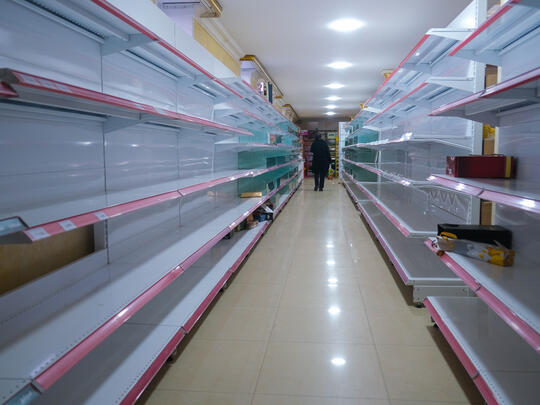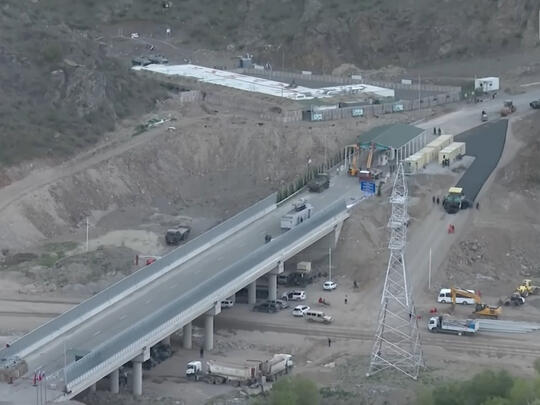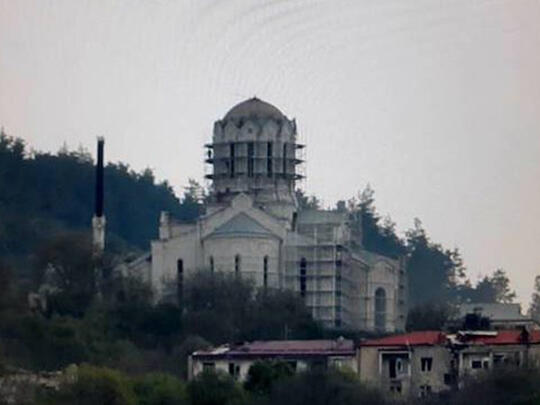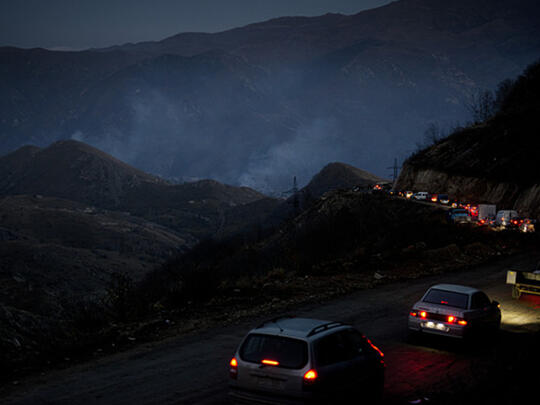October 1, 2023
More than 100,000 refugees arrive in Armenia as a result of Azerbaijan's military operation to retake control of Nagorno-Karabakh (Reuters)
One of the most critical yet frustrating aspects of the conflict over Artsakh (Nagorno-Karabagh) for Armenians is establishing credibility in the face of Azerbaijan's spurious historical claims. That is why AGBU has gone to great lengths to document key facts and references for anyone looking to present a cohesive summary to counter Azerbaijan's propaganda campaigns at home and PR machines worldwide.
In these pages you will find comprehensive references of the history of Armenians living indigenous to the lands, resources for explaining the conflict, timelines and videos, eyewitness testimonies, media articles and more.

More than 100,000 refugees arrive in Armenia as a result of Azerbaijan's military operation to retake control of Nagorno-Karabakh (Reuters)

Nagorno-Karabakh president signs a decree declaring that the ethnic Armenian Artsakh will cease to exist by January 1, 2024 (France 24)

Large explosion rocks warehouse as thousands of ethnic Armenians start to flee their homes in Nagorno-Karabakh (ABC news)

Hundreds of ethnic Armenians have started fleeing Nagorno-Karabakh for the first time since Azerbaijan launched an offensive to seize control of the breakaway territory (Aljazeera)

At least 200 people killed and more than 400 wounded after Azerbaijan launched a military offensive in Artsakh (The Guardian)

Aznavur Saghyan, Mayor of Martuni region in Nagorno-Karabakh killed in Azerbaijani aggression

Azerbaijani forces have taken over Amaras and a number of significant heights. Nagorno-Karabakh forces agree to disarm after 24 hours of Azerbaijan's offensive (Reuters)

Azerbaijan launches a new military operation against Nagorno-Karabakh (BBC)

Nagorno-Karabakh agrees to synchronized transportation of humanitarian cargoes through Lachin and Aghdam-Stepanakert roads (Arka News)

A Russian Red Cross truck crosses from Azerbaijani-held territory into the ethnic Armenian-populated Nagorno-Karabakh region (Reuters)

The inauguration ceremony of newly elected President Samvel Shahramanyan takes place in Artsakh (Artsakh Government)

Artsakh President Arayik Harutunyan announces his resignation (The Armenian Mirror-Spectator)

The CCAF and AGBU have taken action to arrange the delivery of crucial humanitarian aid to Nagorno-Karabakh

Armenia calls on the U.N. Security Council to hold an emergency meeting on the worsening humanitarian situation in Nagorno-Karabakh (AP News)

Azerbaijan is asked by the EU Court of HR to provide information about a resident of Artsakh kidnapped while being evacuated by the Red Cross (Foreign Brief)

UN experts urge Azerbaijan to lift Lachin corridor blockade and end humanitarian crisis in Artsakh (United Nations)

Samantha Power, the head of USAID, calls on Azerbaijan to lift Nagorno-Karabakh blockade

Azerbaijan detains 68-year-old Armenian during Medical Transfer. (Eirasianet, Caucasus Watch)

Azerbaijan blocks humanitarian aid convoy sent from Armenia to Nagorno-Karabakh

Artsakh President Arayik Harutyunyan issues a formal disaster declaration

Civilians face a lack of life-saving medication and essentials like hygiene products and baby formula (ICRC)

Miscarriages surge in Nagorno-Karabakh amid widespread food shortages

Azerbaijan again blocks Red Cross from Nagorno-Karabakh

Water outages and gas deficits are the new normal in Gishi, Artsakh

Four Armenian soldiers killed on Wednesday by Azerbaijani fire in Nagorno-Karabakh. (France 24, Politico)

The Lemkin Institute for Genocide Prevention issued a Red Flag Alert for Genocide

Azerbaijan shuts down all traffic between Artsakh and the world, exacerbating shortages and preventing patients from seeking medical care (Eurasianet)

Children from Artsakh call on the UNICEF goodwill ambassadors to be their voices to end the blockade (Artsakh’s Ombudsman)

Sarsang, the largest reservoir in Nagorno-Karabakh, dries up amid Azerbaijan’s blockade

The Armenian Defense Ministry says one of its soldiers was injured by shot fired by Azeri forces near the village of Tegh in Armenia's southern Syunik province (Reuters)

Azerbaijan sets up first checkpoint at the entrance to a vital road to Armenia (Politico)

Four Armenian soldiers killed in Azerbaijani attack (Le Figaro)

Three Armenian policemen killed in a subversive attack by Azerbaijani forces in Artsakh (Le Figaro)

The ICJ indicates a provisional measure to ensure unimpeded movement along the Lachin Corridor

EU is launching a civilian mission to contribute to stability in border areas (IPS)

Amnesty International calls to lift the blockade without any further delay and end the unfolding humanitarian crisis (Libération)

European Parliament adopts a report Calling on Azerbaijan to withdraw the occupied territories of Armenia and unblock Artsakh

Red Cross facilitates transfer of six patients from Artsakh to Armenia for treatment (Los Angeles Times)

Armenia accuses Azerbaijan of ethnic cleansing at International Court of Justice hearing and calls for measures to end blockade (Le Figaro)

European Union approves another 2-years monitoring mission to Armenia-Azerbaijan border (RFI)

Due to the blockade, food stores are empty in Artsakh. Essential supplies, including medicine are running out (France 24)

Azerbaijan cut off the gas supply to Artsakh in an effort to strangle its population during winter. (Open Democracy)

Lachin corridor completely blocked by Azerbaijani leaving 120,000 citizens without access to essential supplies. (The Economist)

The EU sends a "civilian EU mission" to Armenia-Azerbaijan border. (France24)

House Speaker Nancy Pelosi, Congressman Frank Pallone visit Armenia to denounce Azerbaijan's attacks. (New York Times)

On the night of 12–13 September, Azerbaijan launches an attack on sovereign killing hundreds. (The Guardian)

US researchers confirm 98% of cultural Armenian heritage sites in Nakhichevan destroyed by Azerbaijan. (Hyperallergic)

Azerbaijan violates ceasefire attacking military positions of Artsakh, resulting in evacuation of Aghavno, Nerkin Sus and Berdzor. (Horizon)

Moscow accuses Azerbaijan of violating ceasefire as troops move into village of Parukh. (France 24)

Pipeline supplying gas to Artsakh damaged leaving population without heat. (Time)

Azerbaijan claims “restoration” of Ghazanchetsots Holy Savior Cathedral in Shushi. (Public Radio of Armenia)

Evidence of Armenian Church disappearing after Azeri control. (BBC)

The peacemaking forces of the Russian Federation deployed along. (Reuters)

Armenia, Azerbaijan, and Russia signed a trilateral ceasefire agreement. (France Info)

Fear rises as Azerbaijan advances. Artsakh authorities evacuate Stepanakert. (EurasiaNet)

White phosphorus is used by Azerbaijani armed forces. (France 24)

Nearly 90,000 refugees arrive in Armenia as a result of the war. (UNHCR Armenia)

Azerbaijan targets the maternity ward of Stepanakert’s Maternal and Child Health Center. (Greek City Times)

Azerbaijani soldiers publicly execute two Armenians in Hadrut. (Bellingcat)

Holy Saviour Cathedral in Shushi (St. Ghazanchetsots) is bombed. (BBC)

Cluster munitions fired by Azerbaijan into Stepanakert are identified. (Amnesty International)

Turkey sends Syrian mercenaries to support Azerbaijan. (Reuters)

Azerbaijan launches large-scale attack on Artsakh using artillery, rockets and drones and aircraft. (Forbes)
Eyewitness accounts
Nothing speaks more clearly than images and voices from on the ground. Below you'll find videos from the inhumane blockade showing the living conditions faced for over 9 months. In addition, we have included eyewitness testimonials from those who lived through the 2020 War inflicted upon innocent lives by Azerbaijan.
We first published this series during the cold winter months of early 2021 to show the world the realities of life under the Azeri blockade of Artsakh. Day after day the people lived without gas or electricity. With no food or supplies allowed into the country supermarket shelves were empty for days, then weeks, then months.
When war besieges the unrecognized Republic of Artsakh (Karabakh), writer and photographer Lika Zakaryan takes cover in a bunker - and begins to write a diary. Little does she know that her words will become the definitive chronicle of the brutal 44-day war. Watch Lika's incredible testimonial and use the film, Invisible Republic, now available for online streaming, as a tool to teach and share the truth during this current moment of humanitarian crisis in Artsakh.
During the 44-day war, AGBU sat down with individuals who fled from Artsakh as well as doctors who were at the frontlines, all of whom wanted to share their stories. Each harrowing testimony reveals the horrors of the surprise attack on their homes and towns and the fear that followed. Watch excerpts from our the Voices of Truth series below.
To view the complete playlist click here.

Armenians are among the small list of ancient civilizations who continue to exist today. The timeline below proves unequivocally that the presence of Armenians on this land goes back millennia and that Armenians are indigenous to the beautiful mountains of Artsakh.

Funerary bas-reliefs at Koshik Hermitage and Gandzasar’s military cemetery.
The principality of Khachen is one of the last medieval eastern Armenian principalities was formed in Artsakh in 821.1
Source:
1. Hewsen, Robert H. (2001). Armenia: A Historical Atlas. Chicago: University of Chicago Press. pp. 118–121. ISBN 0-226-33228-4.

The oldest known Armenian cross-stone “Eghtsu ktor” dated from 866, Vaghuhas village.3
Khachkars (cross-stones) are characteristic of Medieval Christian Armenian art.1 2 Artsakh is home to a very large number of khachkars.
Sources:
1. The Grove Encyclopedia of Medieval Art and Architecture. — Oxford University Press, 2012. — Vol. 2. — p. 222
2. Gough M., The Origins of Christian Art, London, 1973
3. Samvel Karapetyan, Armenia: Illustrated album, Yerevan 2014, p. 435
4. Jean-Michel Thierry and Patrick Donabedian. Les arts arméniens, Paris, 1987. p. 231
5. Christian Armenia Encyclopedia, 2002, p. 222 ISBN 5-89700-016-6։
6. Northern khachkar of Gtichavank is currently exhibited at the old residence of the Catholicos of All Armenians, in Holy Echmiadzin.

Armenian Inscription on the tomb of Hasan-Jalal Dawla in Gandzasar, Artsakh.
Hasan-Jalal Dawla, the founder of the Armenian royal dynasty Hasan-Jalalyans in Khachen (Artsakh), built Gandzasar monastery and is buried there.1
Source:
1. H. Evans. Kings and Power Bases: Sources for Royal Portraits in Armenian Cilicia // From Byzantium to Iran: Armenian Studies in Honour of Nina G. Garsoïan / Edited by Jean-Pierre Mahé, Robert W. Thomson. — Peeters, 1997.

Remains of the Dizak castle (Artsakh) ruled by Melik Avanian family.
Five Armenian Melik (prince) families ruled the five Melikdoms of Karabakh.2
Sources:
1. Christopher J. Walker. The Armenian presence in mountainous Karabakh // Transcaucasian Boundaries / edited by John Wright, Richard Schofield, Suzanne Goldenberg. — Psychology Press, 2004. — P. 93. — ISBN 0203214471.
2. Britannica: English-language encyclopaedia.

Strabo
In his Geographica, Greek historian and geographer Strabo refers to an Armenian region he calls “Orchistene”, which is believed to be the Greek version of the old name of Artsakh.1
Source:
1. Strabo. Geographica, Book XI, Chapter 14

The map dates to 1788 (France).
Kingdom of Greater Armenia during 189 BC - 390 AD including Artsakh province.
Source:
1. L’Arménie majeure dressée sur les auteurs arméniens et divisée en 16 grandes provinces, Bibliothèque nationale de France
Make an impact that will change lives. Donate today.